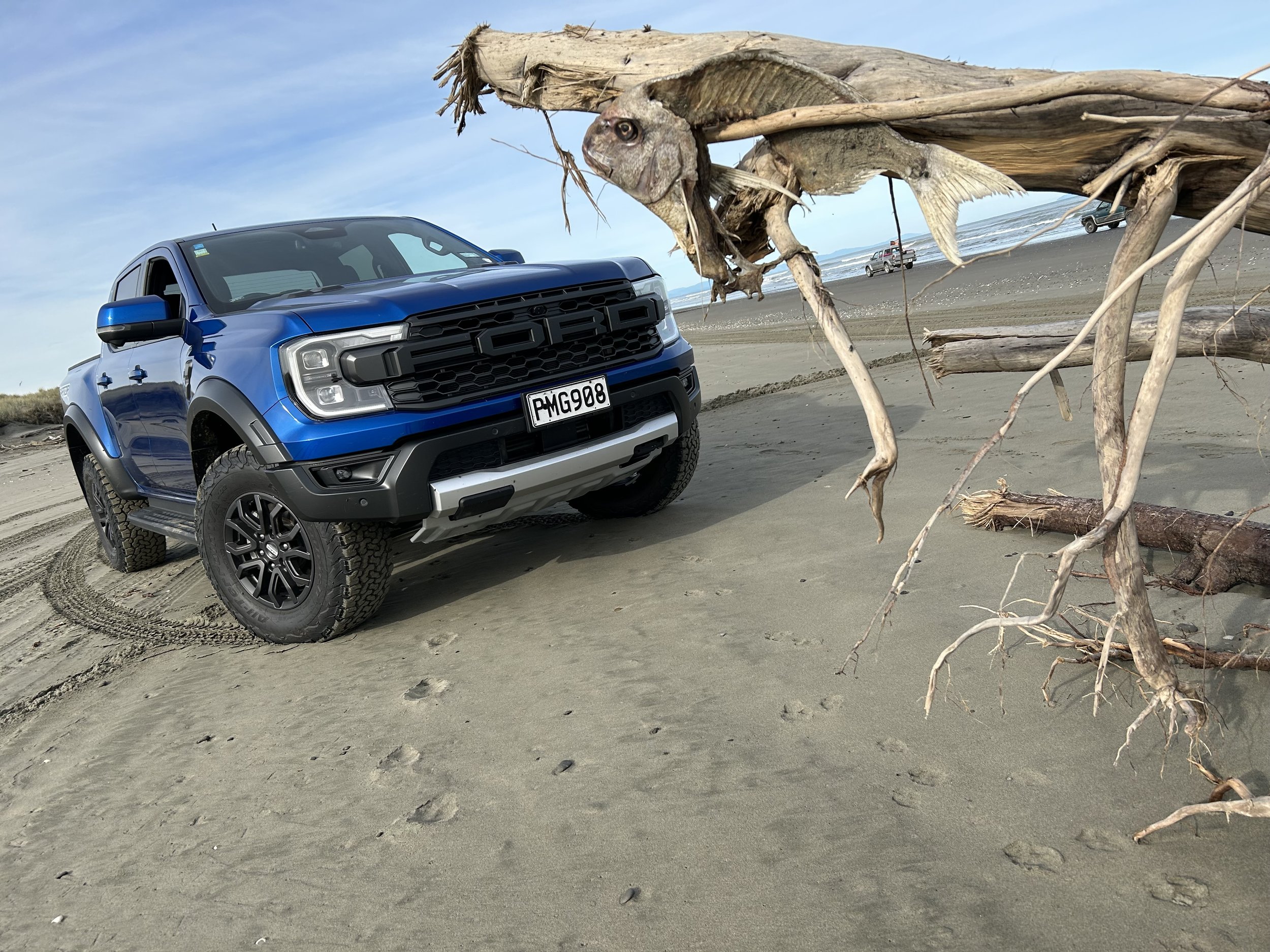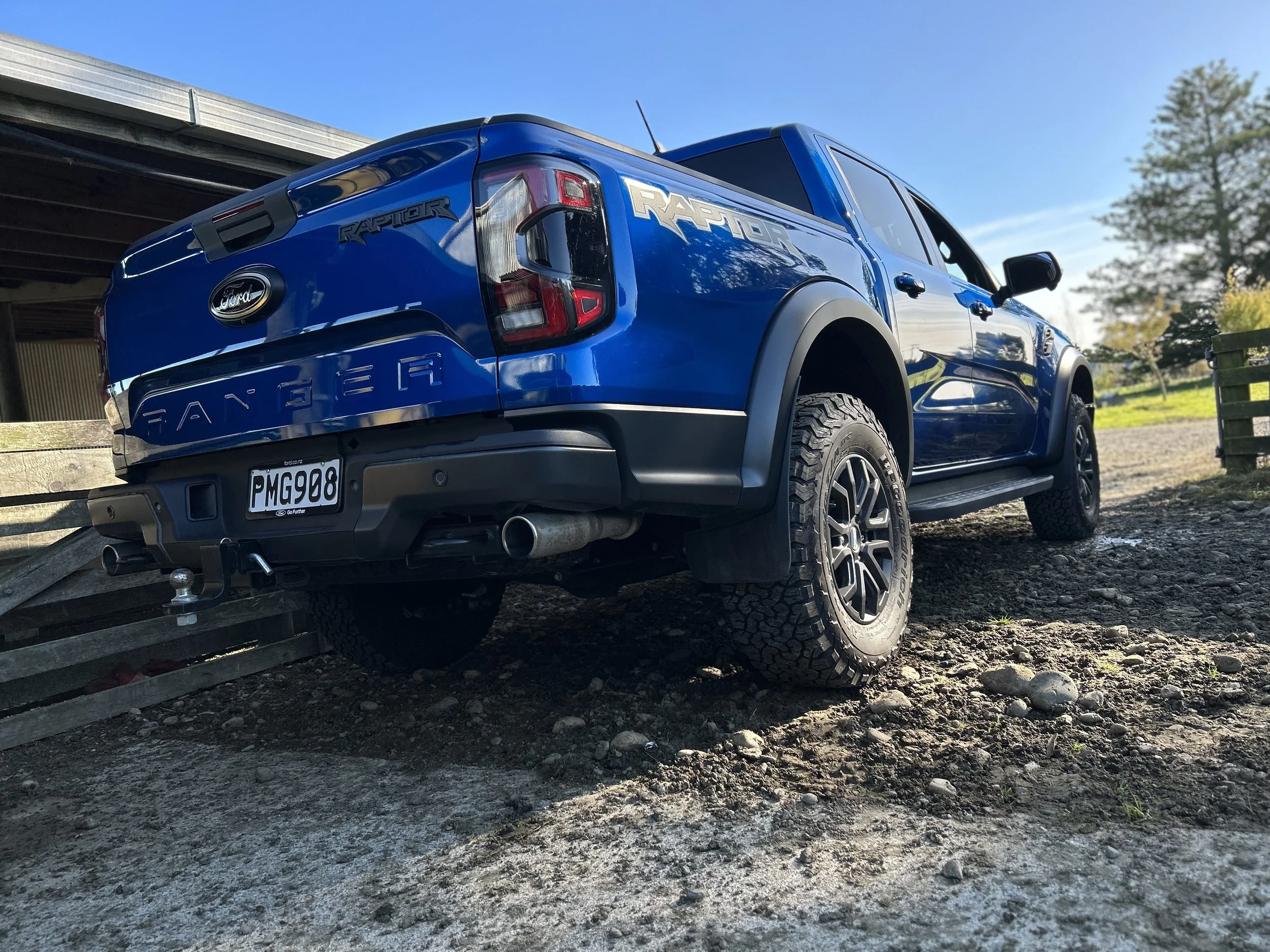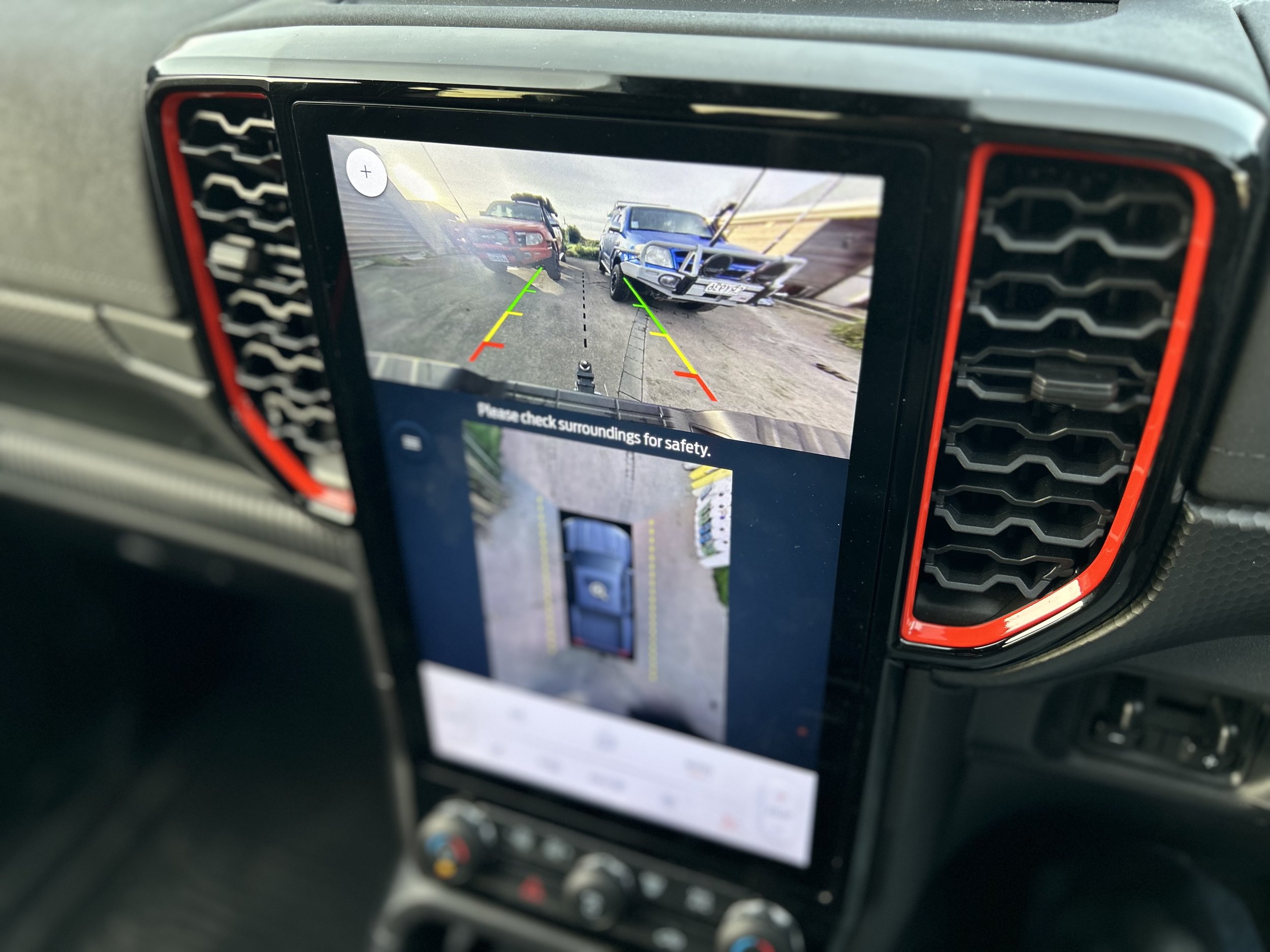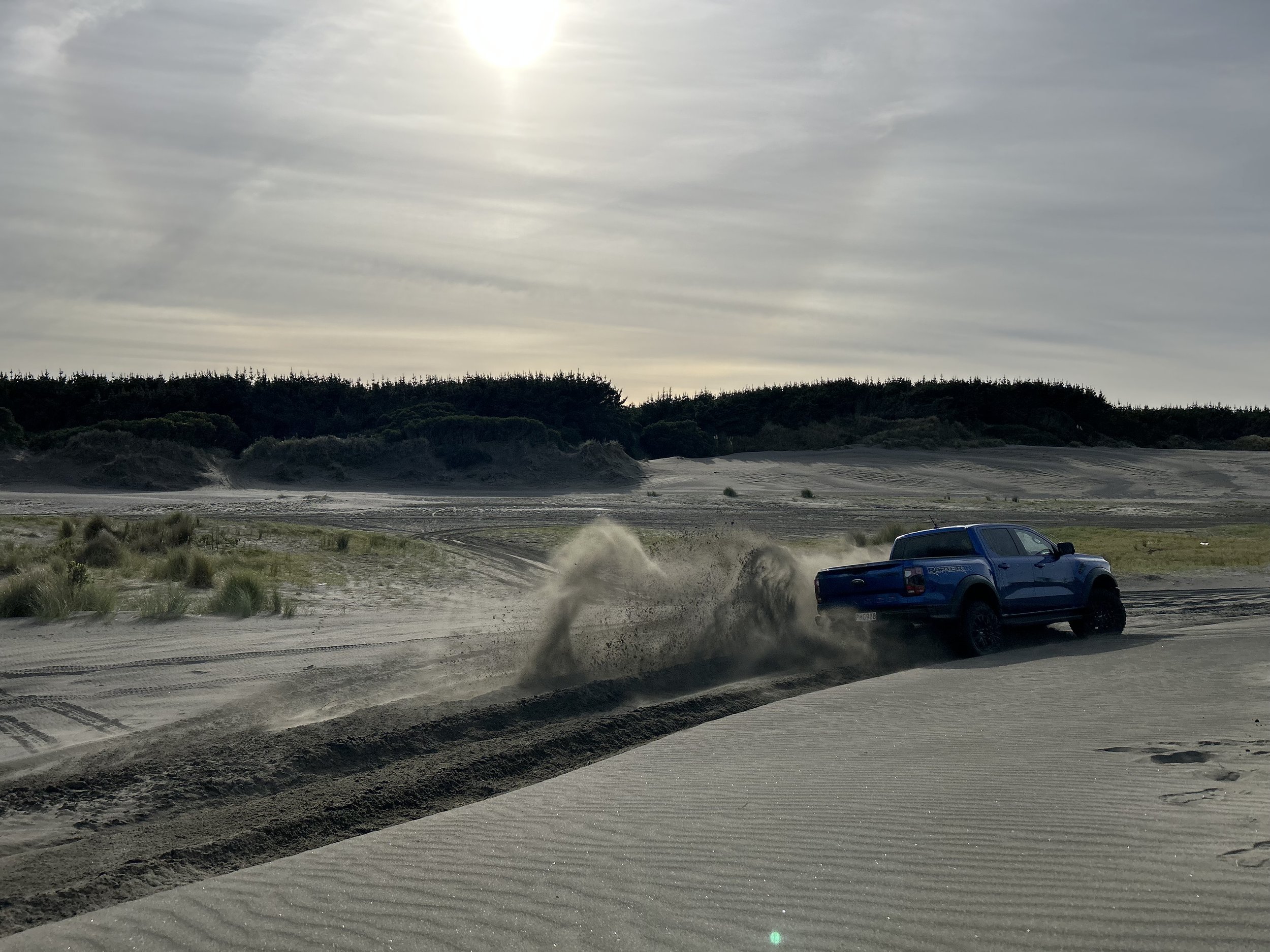Ford Ranger Raptor roadtest review: Unearthly appeal
/A stunning achievement that struggles to make sense in this climate.
Price: $92,990
Powertrain and economy: 3.0-litre twin-turbo petrol V6 with 292kW/583Nm, 11.5L/100km and 262g/km CO2 (WLTP),10-speed automatic.
Vital statistics: 5381mm long, 2028mm wide, 1922mm high, 3270mm wheelbase, towing capacity 2500kg, 17-inch alloy wheels.
Safety: TBA
We like: Astounding technology and engineering.
We don't like: Big thirst, worrisome emissions, wet road behaviour.
THREE litre, twin turbo, V6 petrol - just two recent releases here adopt that recipe and here they were. Side-by-side, in my driveway.
Which of those attention magnets was the more powerful? A simple question with an ‘obvious’ answer. It surely had to be the Nissan Z, right?
Kinda right, but not wholly. That new two-seater is a powerhouse, with considerably more gumbo in its latest format than the predecessor car, itself no slug. With a power output of 298 kiloWatts, it is nonetheless but 6kW ahead of the Ranger Raptor.
When it comes to torque? That’s the big difference. The Z is muscular, but in this company is way much less the alpha bet. Nissan’s sweet six churns out 475Nm … the Ford ute that overshadowed it has 583Nm.
Putting all that into performance context, the Z is still faster to 100 kilometres per hour and is quicker overall. As well it should be. It’s a hard out sports car.
What makes the Raptor kinda remarkable, though, is that it will at most be just one second behind that sleek two-seater in achieving highway pace from a standing start.
Hypothetically -because I wasn’t foolhardy enough to go there - it also has the mojo to thrust so far beyond legal public road speed that, were it caught at max pace, enforcement might well be troubled to believe the capture figure he or she was seeing.
All this, with ridiculous ferocity. Z’s exhaust note has timbre, but everything about the sound and its strength is tempered for a modern age; you can rev it without rattling windows.
Do likewise in the Raptor, particularly in the no-holds-barred Baja mode, and EVERYONE will know. In addition to being tremendously loud; the war cry is incredibly Jurassic. Dogs will run and hide. Or, least, mine did.
Mind you, everything about the Raptor is mad. The look, the dynamics, the specification provision … the fact it even exists.
In respect to the last, it’s reasonable to wonder how long before Ford New Zealand either restricts or wholly curtails its availability. Clean Car is not easy for regular Rangers, but Raptor immediately copes the maximum CO2 penalty, not only at purchase - when the buyer is hit by a fee - but also at distributor level, via separate legislation.
From July 1, the cumulative impact of these imposts could well take this model into the $100k-plus zone, the first one tonne-derived ute to go there in factory-fresh form. As is, it’s already the country’s most expensive tray deck.
Well, you pay for talent, right? Raptor has plenty of that and, despite all Government’s effort to slow ute pick up, Kiwis haven’t been slow to sign on for the Blue Oval’s biggest blast.
The only reason, Ford NZ says, why there are not more Raptors here is that the consignment is limited. There’s a big order bank and most intendees have stayed the course even after ute tax racheted.
I respect their choice, but would question whether it’s a responsible thing to do.
One part of me has massive admiration for this vehicle: At technical level, it is, simply, a masterpiece of design and off-the-wall engineering.
It’s less tailored toward utility and towing than a regular Ranger. One of the downsides of the sophisticated suspension set-up is that cargo carrying is limit to 708kg rather than a tonne, and towing capacity is capped at 2500kg, rather than 3500kg on the bulk of the Ranger line-up.
But compensation is that, by being specialised for off-road adventure, Raptor loads in a whole extra level of talent for undertaking incredible feats that would likely destroy the donor.
The Fox suspension that turns it into a amazing athlete off-road also makes it the best-riding ute on seal. Some critics reckon it has better compliance and bump suppression than a Range Rover, which is saying something. This, and an almost sports car-like dynamic feel - in the dry - make it quite superior to any average ute. While regular Ranger is well-sorted in this respect, it’s down a notch on Raptor.
So there’s that. But there’s also the unavoidable and unpalatable side. Not only is it expensive, but there’s a high environmental price. No other ute in this category emits more CO2 and just one other, an impending Vw Amarok, dares drink petrol, with caveat that - though it will countenance even 91 - it needs to be supping 98 octane for it to perform optimally.
By supping, I mean slurping. I expected the test example to drink heavily when it went off-road for some hard out dune running, and it did, at rate of 16.2 litres per 100km. Likewise, that it would draw more from the tank when towing - for me, that comprised a local short run to get a trailer load of firewood, then towing a mate’s Mazda MX-5 for several hours on the open road. Sure enough, it did, at 15L/100km.
But I kinda hoped it would lean out a lot more when driven gently and unladen. It really didn’t. While consumption specifically from the off-road workout was as bad as it ever got - half a tank gone in under 100kms driven - the tester required two refills during its 10-day sojourn. Overall average came to 14.4 litres per 100km. That’s an expensive habit to feed.
Those who can, and are also trading up from the old Raptor, are in for the ride of their lives.
Apart from turbo count, there’s no comparison between the four-cylinder diesel of the original introduced in 2018 this new mill; so breathtakingly enhanced in the step up in pace and ferocity for this 2.4-tonne vehicle.
For, owners of the old stepping into the new, it’s akin to training to fly in a Cessna then discovering you’ve been picked to pilot Elon’s Mars mission. The difference in experience just reminds how undercooked the previous model was; that biturbo diesel has its merits, but pure stonk was not a strength.
Expect disbelief from relating basis for this new flagship is the Ranger Wildtrak. The Ford Performance treatment is so heavily applied, that DNA is rarely evident. Everything’s turned up to 11. The powertrain snarl is not the only obvious point if difference; a Raptor has a wholly different stance, too, with a widened track required to enable the suspension and even the wheel and tyre choice.
The interior is also dressed for the part. Whatever the exterior colour, Raptor’s have are Code Orange trim highlights - including that strip of leather at the top-dead centre of the steering wheel - the front chairs are bolstered sports types and trimmed in faux suede leather, with Raptor inscriptions. They’re not as good as they look, sadly; lacking side support, especially around the shoulders. In the back, headroom is decent, as is legroom, but the bench seat being shaped as a two-seat layout, with a small centre perch, is different to regular Ranger’s.
Wildtrak elements shared here include pop-out cupholders and a cubby above the glovebox, but Raptor goes more grand with its central vertical touchscreen, getting the largest available 12-inch item. The same one that goes into the latest Volkswagen Amarok, obviously with wholly different presentations even though both are based on Ford’s Synch 3 architecture. Wired and wireless Apple CarPlay – and wired Android Auto – are standard and run through a B and O audio.
Standard safety equipment includes dual frontal, side chest-protecting and side head-protecting (curtain) airbags, driver and passenger knee airbags, and a centre airbag that provides additional protection to front seat occupants in a side-impact crash.
Crash-avoidance technology includes autonomous emergency braking (vehicle-to-vehicle, pedestrian and cyclist detection, and junction assistance), lane-keeping assistance, speed sign recognition (with automatic speed limit control if so desired), blind-spot warning, rear cross-traffic alert and reversing AEB.
The Raptor also has radar cruise control, front and rear parking sensors, a 360-degree camera view, tyre pressure monitors and matrix LED headlights.
Previous Raptor stood out for road comfort - and off-road ability - and new Raptor builds on that, yet also adds another ace card in being properly all-wheel-drive all of the time. The benefit of this cannot be overstated. So many utes that label as ‘four-wheel-drive’ really aren’t, as they have systems that are purely for off-road and demand being in rear-drive for seal.
Ford gives that same choice here, but this time rear-drive is a secondary selection you have to determine to use; otherwise it runs all-paw, with electronics determining how much power goes to each individual wheel. It’s the same system as in the diesel Ranger V6, the high-end Wildtrak X biturbo (and V6 VW Amarok) and is brilliantly effective. I see it as a major selling point.
With Raptor, you’d be silly not to maintain 4A as the default. Though running in 2H is fine, and likely might save some fuel, putting all that power to rear wheels makes it an edgy truck, with easy propensity to kicking its tail, not always with grace. Stay in 4A and it is by far more adept and predictable. You can carry more speed, too.
With respect to one caveat.Raptor runs a chunky three-ply BF Goodrich K02 tyre that, while detracting surprisingly little from the overall comfort, are a compromise choice. You need a nuggety tyre for off-road; this is it. But, as often is the case, there’s trade-off in respect to the sort of grip that’ll arrive on hard surfaces.
In fairness, Raptor has good dry seal performance. It’s when it begins to rain that need to give deference. Towing the race car in a heavy downpour reinforced this. The truck was in 4A, and while the rubber never outright lost tenure, but you sense it dancing from time to time.
This kind of tyre likely has an effect on economy because of the extra resistance on the road and on braking performance; I’d say it requires more stopping space than a regular Ranger. In saying that, I do very much like the brakes. Like everything else about Raptor, they are clearly design to take punishment without complaint.
Raptor’s normal, slippery, sport calibrations are Ranger-like; sport-plus and Baja are Raptor-pure treats. One overseas’ publication ran sprint times in every mode and reckoned there was no difference against the stopwatch. Even so, there’s no question the vehicle feels and sounds more alert and action-ready when it’s in the extreme settings. Perhaps it’s also loudest there.
Baja’s belligerence is best used off-seal; but then, that’s the place where Raptor really shines. While Baja mode suggests it would do best of all in desert conditions, in all probably as long as the tyres can maintain grip and there’s ground clearance, this thing will be pretty decent over most terrain. Locking differentials on the front and rear axles, plus a range of different driving modes to suit every situation, give drivers huge scope. And, again, Fox’s incredibly trick live valve motorsport dampers, which I recently read were first used on Polaris race buggies. They are astounding tech; sublimely responsive to the throttle, steering and what’s going on beneath the truck to stiffen or loosen each corner to keep the body flat, resist roll and absorb bumps to spectacular effect.
On the sand country I ran in, the engine’s brawn came into play. You could use the torque to pull up seemingly impossible angles and surfaces, sometimes at rapid enough pace to lift the front wheels when cresting. Getting air is a situation the shocks are, of course, designed to cope with, at least to certain degree. You’d be foolish to go totally Monster Truck, no matter how tempting that might be.
When fossicking around the sand, in an area designated for just this sort of play I’d hasten, we first played with ‘low’ range and holding the 10-speed transmission in lower gears. But before long it dawned that it was better to select Drive and the specific Sand drive mode, whose tailoring includes giving preference to ‘high’ range. In these, the Raptor was very capable, much faster and theatrically loud in Baja. All in all, enormous fun.
Allowed to run free in wide open spaces, it’s very likely the best thing out there. Taken into more restrictive environments? like any one-tonne ute, it copes but clearly isn’t happy. What exacerbates for Raptor is that widened track; what makes it so stable also lends a bigger turning circle, of 13 metres, than the regular Ranger. The bulked up bodywork also makes it a higher squeeze in carparks. I’ve written before about the electronic gearshifter being annoying because it’s too easy to put the selector into Park when in fact you want reverse. That crops up more often in Raptor because all manoeuvring in the street seems to turn in a complex series of back and forward movement.
In summary? At technical level, it’s a brilliant, brilliant thing. The breadth of ability on-road or off-road is stupendous. There’s no doubt that Raptor now has the performance thrill it deserves.
The problem is the powertrain technology it uses to achieve this. When I attended this model’s Australasian launch, the obvious question was put: Why wasn’t there also a version with the turbodiesel V6, which not resolving the CO2 issue and unlikely to match on power output, would at least provision better economy and perhaps even more torque?
The answer, basically, is because the petrol was available (it’s from Ford North America’s Bronco) and seemed the ‘right’ thing to have. A decision was made, the coin landed Stateside up. The diesel was not, nor will be, contemplated.
In an international, even Australian, environment, that all makes sense. In New Zealand, though, it surely has to be a decision that could ultimately cost Ford and Raptor buyers dearly.
Every fresh evidence of climate change is bad news. With scientists now predicting a 66 percent chance the Earth is heading to break a key temperature limit - namely the 1.5C global warming threshold - between now and 2027, there will be many who say we simply cannot afford this kind of product, no matter how amazing it is.
There are others though, who will nonetheless take the hit of increasing cost associated with these vehicles - not least to do with feeding them - on grounds it could well be their last chance to enjoy their gut-wringing barbarity.
























